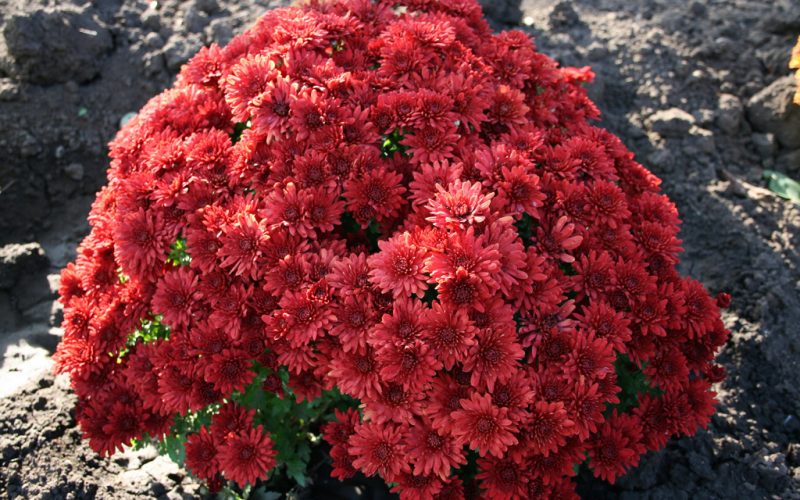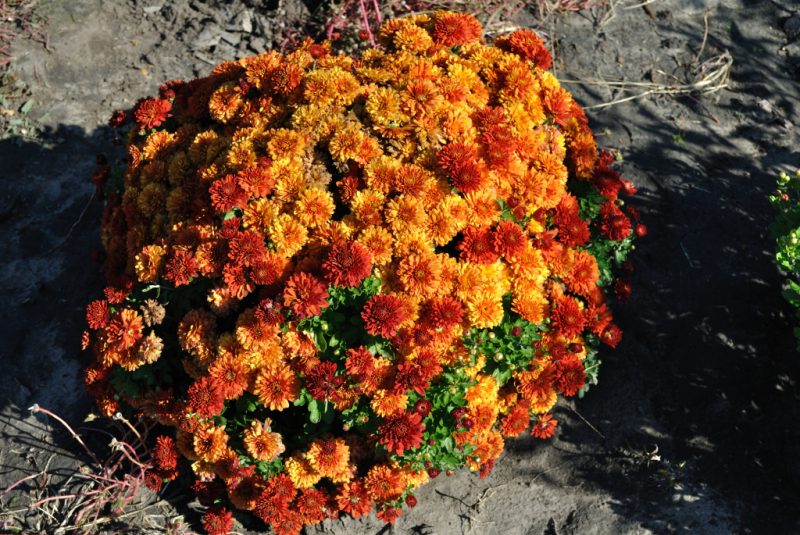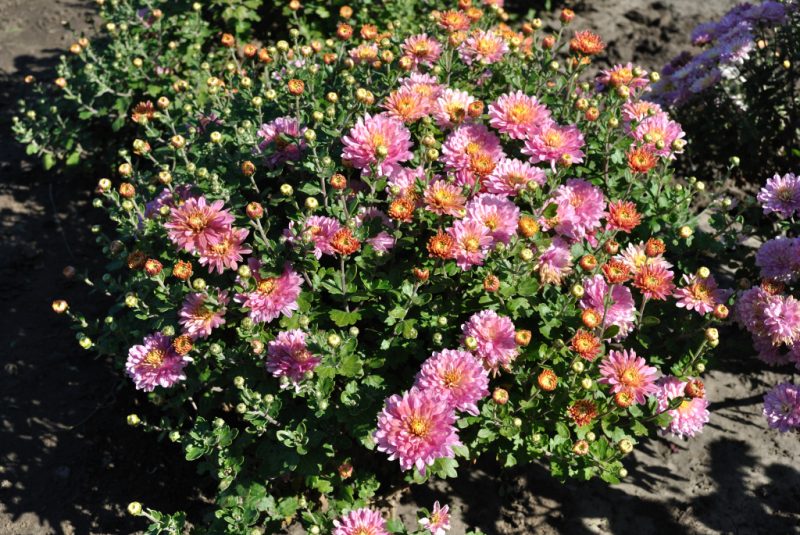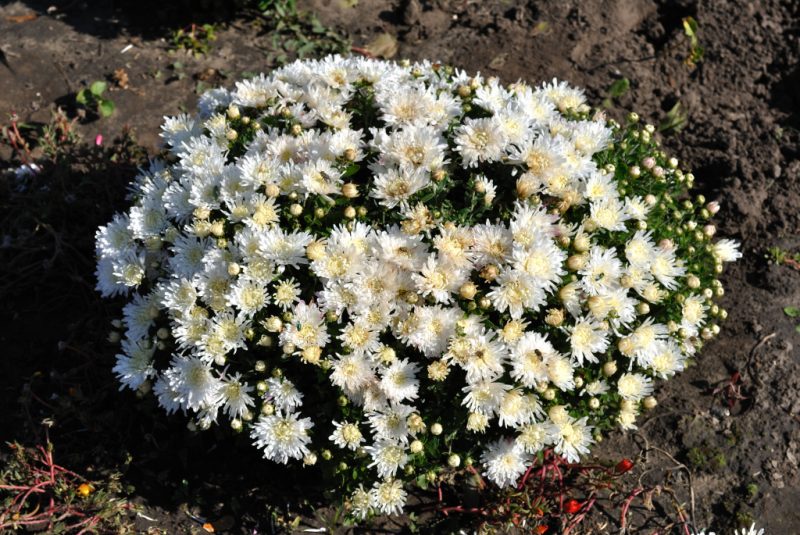Spherical chrysanthemums are one of the most beloved country flowers due to their beauty and unpretentiousness. With their help, you can refresh the landscape design and give the garden a more comfortable look. Reproduction, cultivation and care of spherical chrysanthemums are not difficult even for beginners. What varieties of the plant under discussion exist, how to propagate and care for it correctly to obtain beautiful and abundantly flowering bushes? About all this - in this article.
Material Content:
Varieties and their descriptions

There are many varieties of the described plant, but the most popular are:
- Chrysanthemum "Multiflora". This is the most popular variety. The flowers are small, the palette is diverse, flowering begins in early autumn.
- "Knop." The bush is low with abundant flowering yellow.
- "Ida". The bush can reach a height of 60 cm, small inflorescences are scattered on it. The flowering period begins in September.
According to gardeners, it is these varieties that have optimal vitality, beautiful flowering and relative unpretentiousness.
The nuances of growing flowers
A distinctive feature of spherical chrysanthemums is that they are not planted and propagated with the help of seeds, since such “children” do not possess varietal characters. This makes it almost impossible to obtain classic flowers, the result may be the most unexpected.

Therefore, for this plant using the method of cuttings and the use of sleeping rhizomes. Thanks to this, the flower is very likely to grow to the right size and bloom on time.
However, with such methods of cultivation, gardeners, especially beginners, should pay attention to the following nuances:
- Planting material needs to be bought only in the spring, when the planting season begins. This will help to verify the quality of the material and protect against the purchase of non-viable flowers.
- Rhizomes should be carefully inspected before acquisition. They can not be stains and signs of decay, they should not give the impression of being dry.
The flower should be planted in the spring, after the first grass appears. It is important to make sure that the soil is not frozen and that it will not be difficult to dig.
A distinctive feature is that chrysanthemums can be planted in pots. It is only important to properly prepare the soil.
- To do this, mix peat and earth, additionally add sand (1/4 of the total volume).
- At the bottom of the pot spread drainage.
- And only then pour the mixture for planting.
The volume of the planting capacity must be at least 5 liters for one seedling
Outdoor landing

In order for the flower to take up well and bloom on time, during planting, some subtleties should be observed:
- Care should be taken in advance so that the rhizomes “wake up” by the time they land in the open ground. To do this, they should be gently sprayed with water and placed in a box. For several days they should be in a warm, bright room without direct contact with sunlight. As soon as the first green shoots appear, chrysanthemum can be planted in the ground.
- Before planting, the soil is prepared: weeds are harvested, loosened and watered.
- Landing is done in cloudy, best of all, in rainy weather. This will help keep the flower healthy. In dry periods, the plant is planted in the ground early in the morning or late in the evening, mainly at dusk. For one seedling, dig a hole 40 cm deep.
- The first few days after planting, it is important to ensure that direct sunlight does not fall on the flower. If this happens, then shading should be created, as the sun will burn the young shoots.
- The plant requires constant monitoring for the first 14 days, as it is important to check the level of soil moisture. After this period, the flower will grow independently and do not require increased attention.
By following these recommendations, you can achieve stable growth and good flowering of chrysanthemum.
Chrysanthemums spherical: leaving
In order for the flower to live in the garden for as long as possible, you should familiarize yourself with the rules for watering, feeding and transplanting it. In this case, the spherical chrysanthemum will become a decoration of the landscape for many years.
Watering a plant
If the spherical chrysanthemum grows in a pot, then it should be watered daily with bottled, rain or standing water. Tap is not suitable because of the large amount of chlorine.

Garden flowers may have enough natural rainfall. And in dry periods, the plant is periodically watered in the early morning, trying not to get on the leaves in order to avoid the appearance of burns. Up to three liters of water may be required for one bush.
Fertilizer and fertilizer

Chrysanthemum does not require constant fertilizers and top dressing. Experienced gardeners advise to apply fertilizer with a nitrogen content once in the spring, and then navigate by the state of the flowers. In this case, it is sometimes forbidden to pour a little crushed eggshell or finely chopped banana peel under the bush, since these products are sources of calcium, potassium and magnesium.
It is important not to overfeed the plant. The less fertilizer applied, the better.
Care after flowering
After the flowering period has come to an end, it is recommended to prune the plant so that the ground part becomes no more than 10 cm in height. This will protect the flower from parasites and diseases, and also help to stimulate the abundant growth of root shoots. Thanks to this, it will be possible to expect abundant flowering next year.
Transfer
The spherical chrysanthemum is transplanted in the spring, when the earth warms up, and the risk of night frost is minimized.

To do this, rhizome with emerging shoots is dug up and transplanted to a new place in previously prepared soil. After 3 weeks, the plant will fully take root in a new place.
How to save flowers in winter
Chrysanthemums do not belong to frost-resistant plant species, so they should either be dug up for the winter, or pruned and mulched. The choice of method depends on personal preference, but experienced gardeners prefer to cover the plant.

To preserve the flower in winter, proceed as follows:
- In October, chrysanthemum enters the final phase of flowering. At this time, all stems are cut so that no more than 10 cm of shoots remain above the surface of the earth. After that, shelter is made with dried flowers. This method is good because the flower is reliably protected from pests, and with the advent of spring it will quickly release new shoots.
- If the plant grows in a cold climate with severe frosts and regular freezing of the soil, you should think about moving it to a warm place for wintering. To do this, they carefully dig it out, transplant it into pre-prepared pots and put it on the balcony or in the winter garden. In April, they wake up the chrysanthemum by moving the pot to a warm place without direct sunlight.
It is important to remember that leaving the flower without shelter overwintering is possible only in the southern regions. In all other cases, chrysanthemum should be protected from the harmful effects of cold temperatures.
Propagation of spherical chrysanthemum
The plant is propagated in three ways: the division of cuttings, root system and bush. However, the most popular is precisely the cuttings. This method is simple and accessible even to beginners, and the risk that the flower does not take root is minimized.

Let's consider it in more detail:
- Cuttings from rhizomes. The lead time is spring, when the rhizomes of the plant begin to awaken from hibernation. After the first green shoots of at least 10 cm long appear on them, they are cut and planted in the ground. This method is also good because it allows you to rejuvenate old bushes, and the plant retains its species qualities for a long time.
- From a green plant. To do this, young shoots are cut from the bush and put in a container with water. After the appearance of the first roots, the flower is planted in a pot or in open ground.
You should carefully prepare for this procedure: hands and cutting tools must be clean so as not to provoke the onset of rotting of the chrysanthemum.
Plant diseases and pests
Chrysanthemum begins to hurt in cases where caring for it is incorrect.

The main diseases and pests include:
- Aphid and spider mite. To avoid them, the plant should be regularly watered, especially in dry weather.
- To protect chrysanthemum from bacterial infections, you need to periodically treat the soil with preparations such as Previkur. They are good preventative measures.
- To prevent a disease such as root rot, a little Fitosporin should be added to the water tank when watering.
- The greatest danger to the plant is caterpillars, as they eat flowers and buds. In this case, there is only one method - regular inspection of the plant and removal of unwanted insects.
Spherical chrysanthemum is a fairly painful flower. Therefore, in the absence of provoking factors, she is not threatened with serious diseases.
To obtain beautiful and abundantly flowering bushes, you should carefully care for the plant, do not overfeed and timely respond to emerging problems. Then the cultivation of this beautiful flower will be possible not only in warm, but also in cold regions.












